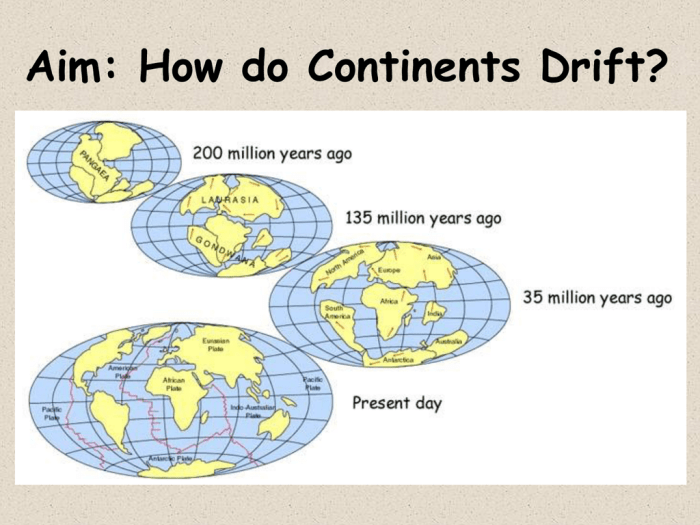Welcome to the realm of Section 9.1 Continental Drift Answer Key, where the enigmatic dance of tectonic plates unravels the secrets of our planet’s ever-changing visage. Join us on an enlightening journey as we delve into the captivating evidence, processes, and profound implications of continental drift, a theory that has revolutionized our understanding of Earth’s geological evolution.
Continental drift, a cornerstone of plate tectonics, has left an indelible mark on the Earth’s surface, shaping continents, oceans, and ecosystems. Through meticulous scientific inquiry, we have uncovered a treasure trove of evidence that illuminates the dynamic interplay of Earth’s crustal fragments, providing a glimpse into the forces that have molded our planet throughout its vast history.
Plate Tectonics and Continental Drift: Section 9.1 Continental Drift Answer Key

Plate tectonics is the theory that the Earth’s lithosphere, the outermost layer of the Earth, is divided into a number of tectonic plates that move relative to each other. Continental drift is the theory that the continents have moved over time from their original positions.
The theory of continental drift was first proposed by Alfred Wegener in 1912. Wegener’s theory was based on a number of observations, including the fact that the continents fit together like puzzle pieces, the distribution of fossils, and the geological evidence for past climate change.
Evidence for Continental Drift
There is a great deal of evidence to support the theory of continental drift. This evidence includes:
- The fossil record:Fossils of the same plants and animals have been found on continents that are now separated by oceans.
- The geological evidence:The geological formations on different continents match up, indicating that they were once connected.
- The paleomagnetic evidence:The Earth’s magnetic field has reversed its polarity many times over the course of geological history. The paleomagnetic record shows that the continents have moved relative to each other over time.
The Process of Continental Drift
Continental drift is driven by convection currents in the Earth’s mantle. These currents cause the tectonic plates to move, which in turn causes the continents to move.
The process of continental drift is a slow one. The continents move at a rate of about 1-2 centimeters per year.
The Impact of Continental Drift, Section 9.1 continental drift answer key
Continental drift has had a profound impact on the Earth’s surface. The movement of the continents has shaped the Earth’s coastlines, mountains, and rivers.
Continental drift has also had a major impact on climate and ecosystems. The movement of the continents has changed the distribution of land and sea, which in turn has changed the Earth’s climate.
Continental Drift Today
The theory of continental drift is now widely accepted. The theory is supported by a wealth of evidence, and it has been used to explain a wide range of geological phenomena.
Research in the field of continental drift is ongoing. Scientists are working to better understand the process of continental drift and its impact on the Earth’s surface.
Frequently Asked Questions
What is the primary evidence supporting continental drift?
Fossil records, geological formations, and paleomagnetic data provide compelling evidence for continental drift.
How does convection contribute to continental drift?
Convection currents within the Earth’s mantle drive the movement of tectonic plates, leading to continental drift.
What is the significance of seafloor spreading in continental drift?
Seafloor spreading creates new oceanic crust, pushing continents apart and contributing to continental drift.

